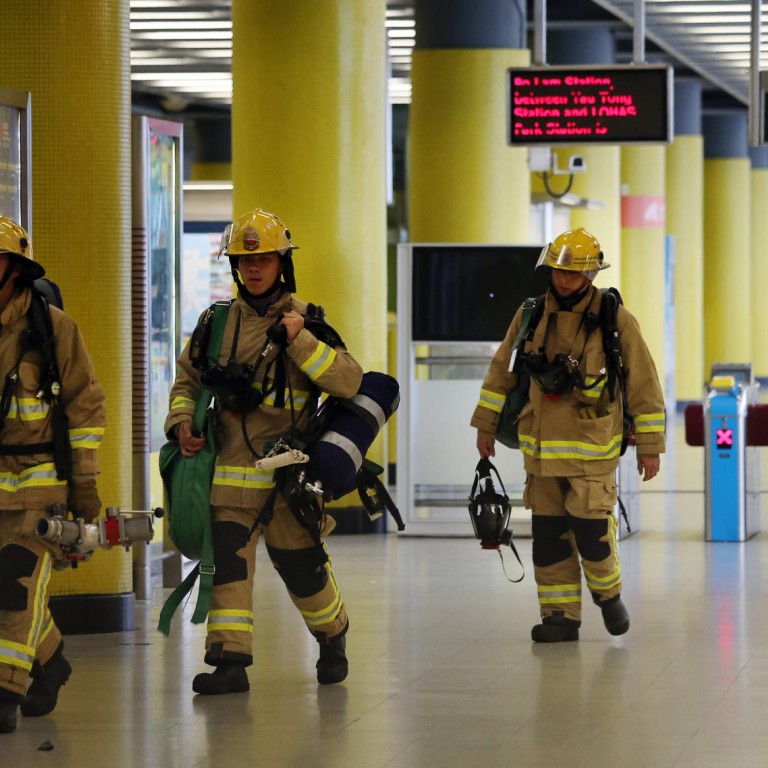
MTR Corp needs better fallback in event of disruptions, experts say
They agree the impact of a shutdown on the Tseung Kwan O line could have been lessened, but say the answer is not more bus services
The MTR Corp should improve contingency plans so that Tseung Kwan O residents - who rely on the railway - are less affected by service disruptions, transport exports say.
But they say existing highways and bus routes should be able to meet the transport needs of the growing population in Tseung Kwan O with the addition of the Central Kowloon Route, connecting West Kowloon with Kai Tak, due for completion in 2020.
However, residents and district councillors claimed the district became a "desert island" last Monday, when MTR services were suspended on the Tseung Kwan O line for five hours.
A 30-metre length of overhead cable came loose between Yau Tong and Tiu Keng Leng stations, forcing two trains to stop and the entire Tseung Kwan O line and shared section of the Kwun Tong line to grind to a halt.
Government figures show the population of Sai Kung district, to which Tseung Kwan O belongs, has grown by nearly a quarter in a decade. Last year there were 438,000 residents. Of the nearly 170,000 workers who crossed the district for work, more than 60 per cent used the MTR, 18.8 per cent took buses, 8.8 per cent private cars, and 7.2 per cent opted for minibuses.
Road use in Tseung Kwan O is also increasing after it fell slightly when the rail link opened in 2002. The average number of vehicles using the Tseung Kwan O tunnel rose by 27.7 per cent to 30 million last year, up from 25 million in 2003. For Tseung Kwan O Road, the rise was 18 per cent. The roads form the major link between Kwun Tong and the district.
NeoDemocrat lawmaker Gary Fan Kwok-wai, who is also a Sai Kung district councillor, said the government should review its policy of making the railway the city's main mode of transport, so that buses and minibuses could operate more routes to compete with the MTR. He said the impact of last Monday's disruption on residents could have been lessened if there were more public transport options.
He also urged the government to speed up construction of a tunnel linking the district with Lam Tin as part of the Central Kowloon Route, as existing roads were becoming more congested.
Veteran civil engineer Greg Wong Chak-yan said that from its inception, the district was designed to rely heavily on the railway and it would be more worrying if traffic were smooth, even with a five-hour disruption on the MTR. "That would mean we have been wasting money and land resources all along by building a railway there," he said.
Wong said it was unreasonable to blame reduced bus services - under a plan by the government and bus firms to rationalise the routes - for delays, but noted contingency measures by the MTR could be improved. "Planning can't be done under the presumption that the railway will always break down," he said.
Polytechnic University transport analyst Dr Hung Wing-tat agreed. "I don't think Tseung Kwan O is especially congested under normal circumstances," he said. "If you're talking about abnormal situations, the airport would be cut off too if Tsing Ma Bridge collapsed."
He added that compared with new towns developed earlier, such as Tuen Mun, transport planning for Tseung Kwan O was not bad. "We can't expect a company to buy and maintain a fleet of vehicles just to prepare for something that may happen once in a decade," he said.
Hung also said Tseung Kwan O's transport system could not be further improved until the Central Kowloon Route was built.
William Lam Hing-keung, chair professor of civil and transport engineering at PolyU, said the railway's failure rate was not high, although when something did happen, the impact was big. "The MTR should work on its contingency measures and dissemination of information. Infrastructure-wise, I don't see many problems in the district," he said.
